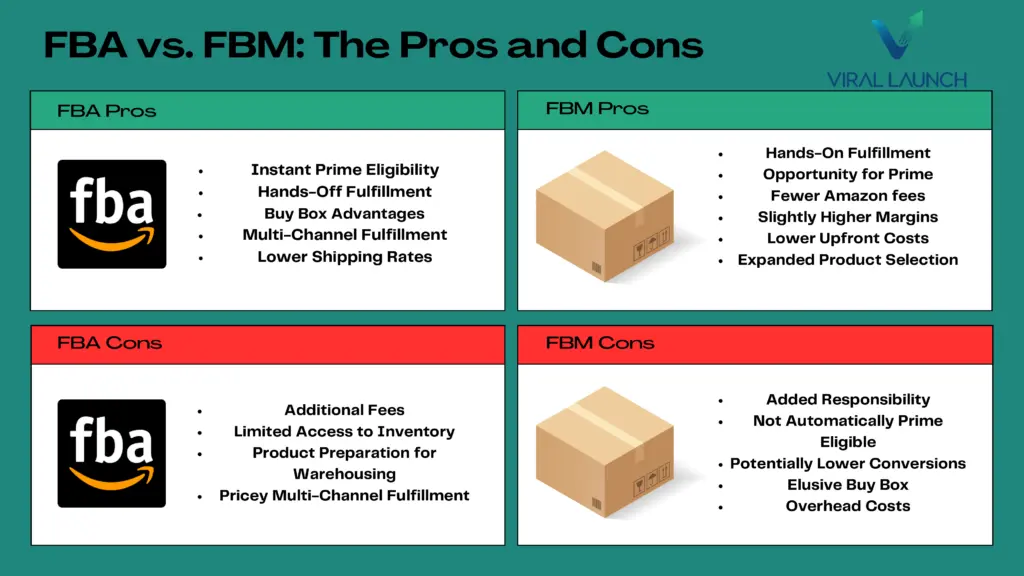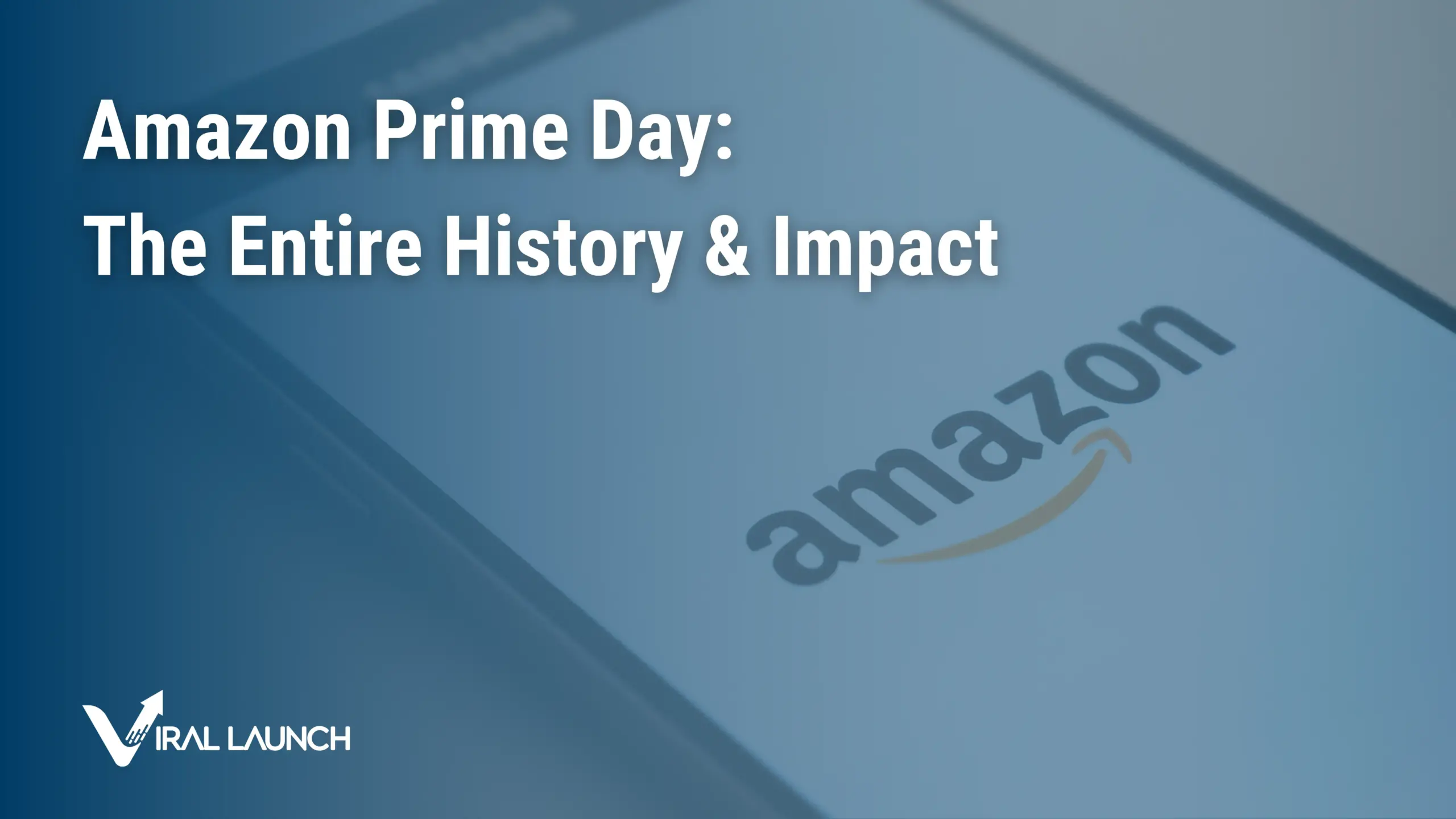Selling on Amazon has become a lucrative opportunity for entrepreneurs and businesses alike, offering access to millions of customers worldwide. Amazon’s two fulfillment options, Fulfillment by Amazon (FBA) and Fulfillment by Merchant (FBM) have empowered tens of thousands to set up and manage their very own online business in Amazon’s billion-dollar marketplace. For sellers looking to become the latest Amazon success story, one of the first and most critical decisions you’ll have to make will be deciding between FBA vs FBM.
Making the right decision can have extremely high stakes, significantly impacting your bottom line. At Viral Launch, we specialize in assisting new and existing sellers in growing and scaling their businesses, so we know how this can be a difficult, stressful choice.
In this comprehensive guide, we’ll explore the intricacies of Amazon FBA and FBM, providing the benefits and downsides of each to help sellers make informed decisions about their businesses. From understanding how each model works to weighing the pros and cons, we’ll address the most critical touchpoints of each fulfillment method to help you decide the best option for your business’s unique needs, goals, and resources.
Let’s examine the strengths and weaknesses of these two fulfillment options that Amazon sellers use to realize their entrepreneurial dreams!
What is Amazon FBA?
Overview of Amazon FBA
Fulfillment by Amazon (FBA) is a program offered by Amazon that allows sellers to store their products in Amazon’s fulfillment centers. When a customer places an order, Amazon picks, packs, and ships the product on behalf of the seller.
Since its introduction in 2006, FBA has been a game-changer for many sellers. It essentially involves outsourcing your storage, packaging, and shipping needs to Amazon. Once your products arrive at an Amazon fulfillment center, the retail giant takes care of the rest, even handling returns and customer service.
By leveraging Amazon’s extensive fulfillment network, sellers can tap into Prime eligibility, allowing their products to benefit from fast and free shipping for Prime members. This enhances the customer experience and boosts visibility and sales potential.
Another way of thinking of FBA is that it is the foundation of Amazon’s customer-friendly marketplace and industry-changing two-day (or less) delivery for Amazon Prime members. Amazon’s fulfillment services have empowered entrepreneurship in ways that were unimaginable just decades ago, relieving business owners of costly and time-consuming aspects of operating a business.
Pros of Using Fulfillment by Amazon (FBA)
Let’s dive into the advantages of FBA and how it can streamline your selling experience on the platform.
- Prime Eligibility: FBA products automatically qualify for Amazon Prime benefits, such as free two-day shipping and the coveted Prime badge. This access to Prime’s vast audience of over 200 million members, committed to fast and free shipping, can significantly boost sales.
- Streamlined Logistics: With FBA, Amazon handles the packing, shipping, and warehousing of your product inventory. This means you don’t have to worry about managing inventory. While costs are involved (we’ll discuss them soon), the time, energy, and opportunity costs of managing inventory and shipping can make the FBA program highly valuable.
- 24/7 Customer Support: FBA offers round-the-clock customer assistance, further reducing responsibilities and costs. Accessible via phone, chat, or email, Amazon Customer Support handles customer inquiries and issues on your behalf. With an 85% customer satisfaction rate and 38% improvement in order defect rate, the reassurance of attentive customer care and improved likelihood of satisfied customers are valuable perks.
- Enhanced Visibility: Buy Box ownership is crucial for maximizing sales on Amazon. FBA sellers have an edge due to factors like faster shipping time, better seller metrics, and Amazon’s top-notch logistics and customer service.
- Subscribe & Save Eligibility: Amazon’s Subscribe & Save program is exclusively available for products in the FBA program. The program entices customers to purchase a product with a percentage off recurring deliveries, increasing the likelihood of repeat customers and boosting brand loyalty.
- Multi-Channel Fulfillment: Are you considering selling beyond Amazon? FBA enables sellers to fulfill orders from various platforms using inventory stored in Amazon’s fulfillment centers, allowing them to diversify and scale easily.
Cons of Amazon FBA
However, these benefits are not without burdens. Here are a few potential downsides to watch out for with FBA.
- Additional Fees: FBA involves various fees, such as fulfillment, monthly inventory storage, closing, and order handling fees. You might encounter additional charges, such as high-volume listing fees, depending on your product category. Additionally, the shipping cost to Amazon’s fulfillment centers and potential long-term and Q4 storage fees should be considered when calculating your bottom line.
- Product Preparation: Labeling products can be time-consuming, particularly for new Amazon sellers. Each unit requires labeling to ensure accurate retrieval from Amazon’s inventory and shipping to customers. You can choose manufacturer or Amazon barcodes, opt for Amazon’s FBA Label Service for a per-item fee, or coordinate with suppliers to handle labeling.
- Limited Inventory Access: Your inventory is stored in Amazon’s fulfillment centers, so access to your products is restricted. Tracking inventory may also become challenging without direct involvement. If any inventory issues arise, you’ll need to rely on Amazon for resolution or arrange to have inventory shipped back to you. For those who like more control, the limited ability to be hands-on with your inventory could outweigh the benefits of taking responsibilities away.
- Storage Limits: FBA imposes storage limits, and sellers may incur additional fees for storing inventory that exceeds these limits, making inventory management crucial. These limits can tighten up during busier times of the year, like the November and December holiday season, impacting how many items you can store in Amazon’s warehouses while increasing the costs of the items stored.
Costs Associated With FBA

Understanding the costs associated with Fulfillment by Amazon (FBA) is crucial for sellers to assess their expenses and optimize profitability accurately. Here’s a breakdown of typical fees:
- Fulfillment Fees: Amazon charges fulfillment fees based on the size and weight of the product, as well as the shipping distance. These fees cover picking, packing, and shipping orders.
- Storage Fees: FBA imposes storage fees for storing inventory in Amazon’s fulfillment centers. Fees vary based on the volume of inventory and whether it’s considered standard or oversized.
- Long-Term Storage Fees: Inventory stored in Amazon’s fulfillment centers for an extended period may incur long-term storage fees in addition to standard storage fees.
- Removal Fees: Sellers can remove inventory from Amazon’s fulfillment centers, but this incurs removal fees based on the size and weight of the product.
- Unplanned Service Fees: Amazon may charge unplanned service fees for issues such as missing or incomplete product labels, overpacked or underpacked shipments, or inventory discrepancies.
What is Amazon FBM?
Overview of FBM
Fulfillment by Merchant (FBM) puts the control back into the hands of the seller.
In contrast to FBA, where Amazon handles order fulfillment, FBM requires sellers to fulfill orders themselves. Sellers store their inventory in their own facilities or third-party warehouses and ship orders directly to customers when sales are made. Generally, FBM shipping allows sellers greater flexibility and control over their operations but requires them to effectively manage logistics, inventory levels, and customer inquiries.
Below, we’ll explore Amazon FBM’s pros and cons to help you understand its appeal and decide if it’s right for your online business.
Pros of Using Amazon FBM
- Greater Control & Freedom: The biggest difference between FBA and FBM is that it gives sellers full control over the shipping process, allowing them to manage stock levels, product packaging, and branding according to their preferences. Sellers can choose their preferred shipping carriers and methods, enabling them to negotiate better rates and provide customized shipping options to customers instead of signing up for Amazon’s more rigid setup.
- Potential for Lower Costs, Higher Profit Margins: By avoiding fulfillment fees, FBM sellers can potentially achieve higher profit margins on each sale, maximizing their earnings. This isn’t always the case, however, and could be negligible depending on the Amazon FBM fees owed by your chosen replacement method.
- Lower Upfront Costs: If you’re a little lower on resources, FBM requires minimal upfront investment compared to FBA, making it more accessible for sellers with limited capital or smaller product catalogs.
- Additional Product Selection: Due to Amazon guidelines and costly fees, certain products simply make more sense to sell via FBM. Items with lower sales volume or niche items that may rack up long-term storage fees, oversized products that require additional fees, and fragile items that require specialized care are often neglected in the FBA model and can cause wildly inefficient operations if not accounted for.
Cons of Using Amazon FBM
- Logistics Management: FBM sellers manage shipping logistics, including packaging, labeling, and selecting shipping carriers. This requires time, resources, and coordination to ensure timely and accurate deliveries, which for inexperienced sellers may be a dealbreaker.
- Customer Service: FBM sellers must handle customer inquiries, returns, and complaints directly, which can be time-consuming and require effective communication and problem-solving skills.
- Scaling Complexities: Scaling with FBM can be more challenging due to increased logistical demands. Each business’s unique structure and interaction with other segments can prove troublesome as it grows and needs change.
- Not Prime Eligible: Fulfilled by Merchant products aren’t eligible for Amazon Prime, potentially limiting visibility and attractiveness to Prime members. With 200 million Amazon Prime members and growing, customers often feel incentivized to purchase Prime-eligible products with fast and cheap shipping. By missing out on these customers or failing to entice them, sales will likely slump and fall short of their full potential.
- Managing Returns: Handling returns and exchanges can be more complex when FBM selling, requiring efficient processes for inspecting, restocking, and processing refunds or exchanges.
FBA vs FBM Compared

Choosing Between FBA and FBM
When deciding between Fulfillment by Amazon (FBA) and Fulfillment by Merchant (FBM), sellers should consider several factors based on their specific business needs, product characteristics, and long-term goals. Here are some key considerations:
- Business Size: Larger businesses with high sales volume may benefit from FBA’s scalability and convenience, while smaller operations with limited resources may find FBM more manageable and cost-effective.
- Product Type: The nature of your products can influence the FBA vs FBM debate. Products with consistent demand and predictable sales patterns may be well-suited for FBA, while niche or specialty products may be better served by FBM.
- Volume: FBA is generally more conducive to high-volume sellers due to its streamlined fulfillment process and scalability. FBM may suit sellers with lower sales volume or seasonal fluctuations.
- Ability to Manage Logistics: Consider your ability to manage shipping logistics, customer service, and inventory control. FBA alleviates this burden, while FBM requires sellers to take a more hands-on approach.
- Cost Considerations: Evaluate the costs associated with each fulfillment method, including fulfillment fees, storage fees, and overhead expenses. Calculate the impact on your profit margins to determine the most cost-effective option.
- Prime Eligibility: Consider the importance of Prime eligibility for your products and target customer base. FBA offers Prime eligibility, while FBM does not, potentially influencing customer perception and purchasing decisions.
- Long-Term Strategy: Assess your long-term goals and growth strategy. FBA may offer greater scalability and market reach, but FBM provides more control and flexibility over your operations.
By carefully weighing these factors of FBA vs FBM and understanding the implications of each fulfillment method, sellers can make an informed decision that aligns with their business objectives and maximizes their success on the Amazon platform.
Best Practices for FBA and FBM Sellers
When juxtaposing FBA vs FBM, the goal of running a profitable online business remains the same. However, each comes with its own points of emphasis to achieve that goal.
5 Helpful FBA Tips
- Manage Costs: Regularly review your FBA fees and expenses to identify areas for optimization. Utilize an Amazon FBA calculator to get a good feel for expected costs associated with selling while getting started, then a third-party tool like Viral Launch’s Listing Analyzer to track your costs and adjust pricing strategies accordingly.
- Optimize Listings: Invest time optimizing your product listings with high-quality images and detailed descriptions with relevant keywords, avoiding common listing mistakes, to improve visibility and conversion rates.
- Ensure Product Quality: Maintain high product quality and packaging standards to minimize the risk of negative reviews and returns. Regularly inspect inventory and address any issues promptly.
- Monitor Inventory Levels: Monitor inventory levels to avoid stockouts or excess inventory. Use Amazon’s inventory management tools to forecast demand and replenish inventory proactively.
- Leverage Advertising: Take advantage of Amazon’s advertising options, such as Sponsored Products and Amazon pay-per-click (PPC), to increase visibility and drive traffic to your listings. Sound complex? Our Kinetic PPC tool helps streamline success by automating your campaigns to meet your goals, shutting off unprofitable ads, and scaling successful campaigns.
5 Helpful FBM Tips
- Efficient Shipping Practices: Implement efficient shipping practices to minimize fulfillment times and provide a positive customer experience. Utilize shipping software and carrier partnerships to streamline the process.
- Top-Notch Customer Service: Provide responsive and helpful customer service to address inquiries, resolve issues, and maintain positive seller feedback. Promptly respond to messages and requests from customers.
- Effective Inventory Management: Implement robust inventory management practices to track stock levels, monitor sales velocity, and prevent stockouts or overstock situations. Utilize inventory management software to streamline operations.
- Optimize Packaging: Optimize product packaging to ensure products are adequately protected during transit and present a professional image to customers. Consider eco-friendly packaging options to appeal to environmentally conscious consumers.
- Offer Competitive Shipping Options: Provide competitive shipping options, such as free or expedited shipping, to attract customers and increase conversion rates. Leverage Amazon’s shipping programs, such as Seller Fulfilled Prime, to offer Prime-like shipping benefits.
Whether you choose FBA or FBM, implementing these practices gets you on the fast track to success by enhancing operations, improving customer satisfaction, and most importantly, driving sales on Amazon.
FBA vs FBM: Which Is Better for Your Business?
When deliberating between Amazon FBA vs FBM, there’s no universal answer that fits every seller’s needs. It’s about recognizing the unique dynamics of your business, considering factors like budget, time constraints, control over the fulfillment process, and scalability.
FBA offers convenience by handling storage, packing, and shipping, making it an attractive option for sellers looking to offload logistical responsibilities and leverage Amazon’s expansive infrastructure. On the other hand, FBM provides greater control over inventory management and customer experience, allowing sellers to customize shipping methods, packaging, and handling to align with their brand identity and customer expectations.
Whether you opt for the convenience of FBA or the control of FBM, Viral Launch is here to support you every step of the way. From finding your first product to optimizing listings to managing inventory and becoming an Amazon ad wizard, our data-driven solutions empower sellers to realize their entrepreneurial dreams, w








